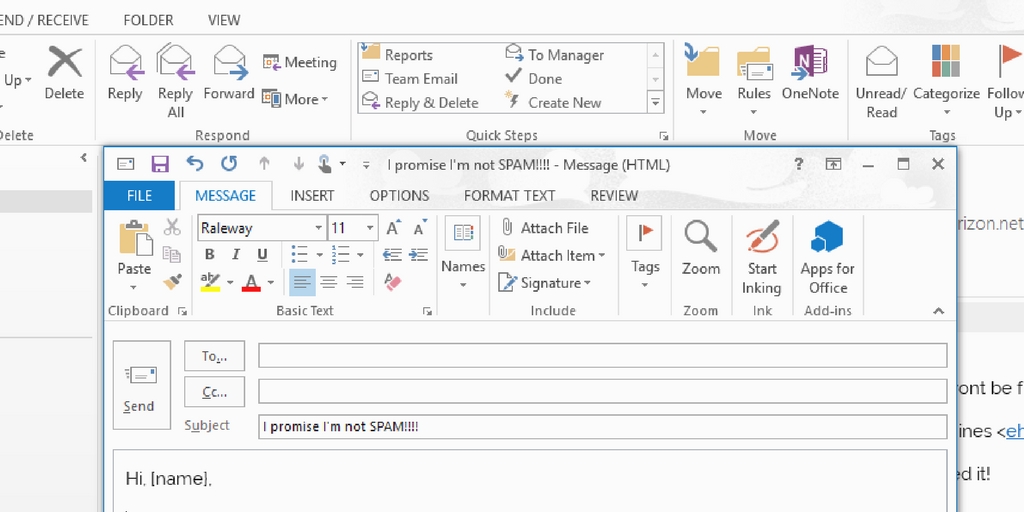
by Fronetics | Jun 5, 2017 | Blog, Content Marketing, Marketing
Don’t risk ruining your open rates by committing these 5 email subject line crimes.
Email marketers, beware: If you’re tasked with writing compelling emails to capture online customers, the subject line — the headline of your message — is the first and main spot to grab the viewer’s attention. But, while a cleverly written subject can boost open rates and click-throughs, a poorly written one can have the opposite effect.
With this in mind, Grammarly and Movable Ink polled 1,100 readers to find out what inspired them to click open, and what they considered their biggest pet peeves when it comes to email subject lines. The results of the latter might surprise you.
Your email subject line can make or break your open rate, so don’t commit these subject line crimes.
5 common email subject line crimes
1) Spelling and grammatical errors
Proofread, proofread and proofread even more. The top reason 35% of people don’t open email is because of errors in the subject line.
Viewers who see an error in the headline assume that the rest of the email has misinformation, and they immediately disengage with its content. So whether you read the email subject line out loud (and even the rest of the email), ask someone else to read it before you hit send. Or use an online spelling/grammar program to check it for you. Just make sure you don’t have errors in the subject line.
2) Using all capital letters
It’s commonly cyber-accepted that anything typed in all capitals translates into being yelled at, and no one likes that. In fact, 24% of survey respondents said this was their biggest pet peeve when it comes to an email subject line.
Don’t mistakenly assume that hitting caps-lock for your email subject line will demand your reader’s attention — it actually does the opposite, and sends your email straight to the trash folder.
3) Excessive use of punctuation
When the email subject line is filled with exclamation points marks or other unnecessary punctuation, such as ellipses or too many commas, 17% of readers are most annoyed and deterred from looking at the message. You don’t want to be perceived as a spammer, by either the receiver’s filtering program or by the reader, so keep the extraneous punctuation to minimum.
4) Misused or broken personalization
Too often emails go out without proper formatting, or with generic placeholder fields left blank. For example, a reader who opens his or her inbox to a message with the subject line, “Hi, [name],” is sure to ditch the message — and lose any respect for the company who sent it. Make sure your email client and any dynamic content within is firing up correctly by sending a test message to yourself and a colleague.
5) Language that is too promotional
Some email subject lines use language that is over-the-top promotional, and readers don’t like it. Temper your language and don’t write subject lines that are too colloquial or filled with jargon.
What about using emojis in subject lines?
Increasingly, marketers are using emojis in subject lines. If used correctly, they may boost your open rate.
Some 56% of brands using emojis in their email subject lines report a higher unique open rate, according to data from Experian. Use of emojis can shorten your subject line, allowing an easy read on a mobile device. But, beware: Not all emojis are readable to every user, so choose wisely and always send a test first.
What bothers you most when it comes to an email subject line? Are there certain subject crimes that will prevent you from opening a marketing email?
Related posts:

by Fronetics | Jun 1, 2017 | Blog, Content Marketing, Marketing, Strategy
Today’s B2B buyer’s journey involves more research, more internet searches, and more social media.
We’ve said it before: The B2B buying process has changed, and you need to adapt. The vast amount of information available on the internet has afforded buyers a level of self-sufficiency that renders traditional sales models moot. It drives the need for new strategies, like content marketing and social media marketing.
How can supply chain and logistics businesses adjust to the new way of doing things? The latest B2B Buyer’s Survey offers insight into how B2B buyers are finding vendors, engaging with them, and — ultimately — deciding to work with one. Some of the statistics are very telling and give vendors a good idea about where they need to invest their time and money in order to get buyers’ attention
10 stats about the B2B buyer’s journey
1) Length of buying process
The B2B buying process is becoming longer and more complex because the majority of buyers (82%) are using more sources to research and evaluate products and services, and they are spending more time in the research phase itself.
2) Web search is first
62% of B2B buyers say that a web search was one of the first three resources they use to learn about a solution.
3) Online eventually
In fact, in a different study, 94% of buyers reported using online research at some point in the purchasing process.
4) Searching for what?
71% of B2B researchers start with a generic search — rather than searching for a particular company.
5) How many searches?
B2B researchers do an average of 12 searches before engaging with a specific brand’s site.
6) Self-sufficiency on the sales path
Buyers are 57% of the way down the sales path by the time they engage with a brand’s website, meaning they have already spent a fair amount of time educating themselves with the enormous amount of information available to them on the internet.
7) Social media plays a role
And content isn’t limited to your website: A vibrant social media presence helps buyers conduct their research. In fact, more than half (53%) of B2B buyers report turning to social media to make buying decisions.
8) (More than ever)
What’s more, more than a third (34%) say they are spending more time this year than last using social media to research vendors and solutions.
9) LinkedIn is B2B’s network of choice
LinkedIn is reportedly the most impactful to the research process. 81% of respondents said it was very important or somewhat important.
10) But don’t discount video
And, believe it or not, video sites like YouTube and Vimeo are playing an increasingly important role in the B2B buyer’s journey, with 60% of respondents ranking them very important or somewhat important.
Related posts:

by Fronetics | May 23, 2017 | Blog, Marketing, Social Media
If you’re a large company not using social media for all that it’s worth, you’re missing out on customers and business.
We know that the majority of businesses participate in social media — in fact, a dominant 88% of B2B marketers report using these platforms as part of their marketing programs. Large corporations, small businesses, and those in between are promoting their brands and engaging with customers online. Even companies within the logistics and supply chain industries are reaping the benefits of social media marketing.
The truth is, if your company is not participating in social media, you are at a disadvantage. Your customers, your employees, and your competitors are taking advantage of these technologies to conduct business in new, more efficient ways.
Content Marketing Institute’s new report on B2B enterprise companies (companies with over 1,000 employees) shows that large corporations are also jumping on the social media bandwagon. Here are some stats:
- 87% of B2B enterprise companies use LinkedIn
- 81% use Twitter
- 77% use YouTube
- 74% use Facebook
But when asked about the importance each of these channels to their organization’s content marketing success, 87% felt that email is still the most effective tool for distributing content.
What does that say to you? These enterprises are using social media for content distribution, but their heads aren’t in the social media game.
So, why should their social media efforts be turned up?
Let the numbers speak for themselves:
Businesses are using social media, so if your B2B enterprise company isn’t, you’re already behind the eight ball. Social media is a great way to distribute information to a vast audience in a quick, cost-effective manner.
Social media also allows you to get to know your audience in a more personal way. After a few weeks and months of committing to your content marketing strategy on social media platforms, you’ll know what your target audience likes and what they’re interested in. The more time and effort put into your social media campaign, the more refined and effective it will become.
And we can’t ignore that your competitors are already out there, happily exploring the online market share.
Social media platforms have already proven their worth and most companies, big and small, have embraced their value. If your enterprise company hasn’t, it’s time to get your foot in the game.
Related posts:


by Fronetics | May 22, 2017 | Blog, Content Marketing, Marketing, Social Media
B2B enterprises with 1000+ employees face unique content marketing challenges that can hinder a program’s overall success.
Bigger isn’t always better. Or, maybe I should say, bigger companies don’t always have it easy.
Big marketing budgets and a big marketing staff have their perks — but they also have their share of challenges. The Content Marketing Institute’s 2017 B2B Enterprise Content Marketing Report, which surveys B2B companies with over 1,000 employees (enterprise marketers), brings many of these issues to light.
The challenges these enterprises face, of course, are quite different from those of their small- and mid-sized counterparts. Here are some of the top differences:
- 72% of B2B marketers agree that their organization is focused more on building long-term relationships than getting quick results. Only 58% of B2B enterprise marketers agree with that statement.
- 52% of B2B marketers agree that their leadership team gives ample time to produce content marketing results (which typically take longer than other marketing approaches). Only 38% of B2B enterprise employees agree that leadership supports their longer efforts.
- 69% of B2B marketers agree that their organization is almost always or frequently focused on creating content for an audience, instead of their brand. 47% of B2B enterprise marketers feel their focus on the brand.
Pressure to produce results quickly is a death sentence for content marketing. And being forced to create content for a brand, rather than a specific audience, can be detrimental to content marketing results. Yes, challenges facing these enterprise marketers are often as large as the companies for which they work.
Let’s take a look at some of the reasons why that is, and a few solutions for solving them.
3 enterprise-level content marketing challenges
1) Organization
While the CMI Report found that 88% of B2B enterprise companies are using content marketing, a mere 2% felt their content marketing strategy was “sophisticated.” Organization might have something to do with that.
Most enterprise organizations have staff that are responsible for multiple brands and product lines throughout the company. Their time is split developing strategies for different marketing programs. Smaller operations, on the other hand, can focus on a single brand, devoting time to developing and implementing a comprehensive strategy that the team can live and breathe — instead of toggling back and forth between programs all day long.
Solution: Outsourcing can be an enterprise’s best friend. A third-party vendor can dedicate itself fully to creating a content marketing strategy that best fits individual products or brands. And the vendor can even drive the strategy, if the enterprise’s resources are so taxed. Check out these 13 stats about outsourcing content marketing to learn more.
2) Clarity
It’s difficult to deem a program effective if there is no clear vision of success looks like. Yet, almost half (45%) of B2B enterprise companies feel their organizations lack clarity for benchmarking success. You can see the problem there.
Oftentimes, especially in larger organizations, the C-suite has a very different idea about what makes a content marketing program successful (i.e., leads and sales), whereas the marketers developing the strategy know that other benefits (e.g., increased brand awareness, social reach) have long-term value.
Solution: Education is key here. For one, set realistic expectations about the length of time it will take to generate tangible results from your content marketing program. Further, marketers need to learn to speak their bosses’ language when it comes to winning support for content marketing. They should regularly report on all progress to show how, over time, “smaller” victories (like growing social media engagement) translates to leads and sales. Check out our Monthly Marketing Reporting Template for some ideas.
3) Content Distribution
As more organizations recognize the benefits of content marketing, they’re ramping up production of content. In fact, 63% of survey enterprise-level respondents reported increasing the amount of content they produce from 2016. That’s great, but — the question is — does more content definitely equal better results?
The answer is not necessarily. Content distribution plays a huge role in getting the most out of what you’re producing. And here’s where the enterprise-level marketing problem lies: 94% of B2B enterprises are using email as their main distribution channel.
I’ve written before about how organizations spend too much time creating marketing emails. I believe organizations tend to stick with this content distribution channel because they see immediate results in the form of open rates and click-throughs. But the reality is that these companies are trying to squeeze water from the same well over and over again. At some point, they’re going to run out.
Solution: Don’t get me wrong: Email marketing is an important component of a well-rounded content distribution strategy. But so are publishing on social media and blogging (on your website and others!). These distribution channels help you reach new prospects who are searching for products and services like yours. Make sure your content distribution strategy includes a variety of platforms instead of just relying on one (like email) or just a few.
It is important to note that there are many B2B enterprise organizations that have highly successful content marketing strategies. Companies like Cisco and Boeing, who are committed to content marketing, have created ways to define what a successful content marketing program looks like and to effectively measure content marketing ROI.
The differences between B2B enterprise content marketing and B2B content marketing overall are tangible but not defining. These larger organizations have the ability to make changes that can redefine their content marketing programs and open the door to endless opportunities.
Related posts:

by Fronetics | May 8, 2017 | Blog, Content Marketing, Marketing
Research shows that marketers are wasting valuable time and resources reinventing the wheel when it comes to email marketing.
Email marketing can be a challenge — to say the least. The constantly changing email landscape, marketing trends, and privacy regulations can make staying on top of your email game very tough.
The Litmus 2017 State of Email Report looks at trends in email marketing over the last year. One interesting takeaway: The definition of ‘spam’ email is changing at lightning speed. Consumers are quick to label unwanted or uninteresting emails as spam. That means it’s more likely the content you’re creating won’t make it to your audience’s inbox.
So marketers should spend more time and resources creating better emails, right? Not necessarily. The study shows that many aren’t using their resources wisely when it comes to marketing emails.
One thing is clear: Companies have to drive relevant and timely email communications that align with subscribers’ interests to stand out. But spending more time on different designs and reinventing the wheel when it comes to copy aren’t necessarily the way to go about that.
Take a look at these 4 statistics from the report and why streamlining and automating certain aspects of your email marketing program might free you up to focus on factors that can make a difference.
4 takeaways from the Litmus 2017 State of Email Report
1) 41.5% of companies have 1-5 emails in production at any given time (from conception to send).
That is a lot of emails. If you’re working on 5 emails at a time, it’s important that you have a process for turning them over quickly. But Litmus found that companies are spending way too much unnecessary time thinking about, creating and producing emails.
Why start from scratch with every one? Email templates are an excellent way to streamline your production process. It’s also easier to concept an email when you have certain standard elements that you have to come up with each time. You can still swap out messaging and images while keeping brand-specific pieces in place. It’s a time-saver for all involved.
2) Only 31.6% of companies spend less than a week to produce a single email.
So over 68% of companies are spending a week or more on ONE email. If most marketers send out 1-3 emails a month, imagine how those weeks add up! How does anyone have any time to do anything else?
This means too many marketers are spending too much time on each email. Automating certain parts of your process can be a beautiful thing — saving you time, money, and, ultimately, your sanity.
3) Only 6.7% of marketers use task runners as a part of their email production flow.
Task runners automate repetitive tasks, such as inlining CSS and sending out test emails. The biggest benefit to using a task runner is the ability to save time. Using Grunt, a popular task runner, not only adds to efficiency, but also builds consistency, increases effectiveness, and offers task flexibility.
4) Only 5% of marketers are using static site generators as a part of their email production workflow.
Static site generators are build systems for flat files that allow you to create templates and break down email elements. For all of us non-coders, this means that when someone visits your webpage, the user sees exactly what is stored, in contrast to a dynamic webpage that is generated through an application. Using static site generators can save marketers time, improve reliability, and increase security.
So what does all this mean for you and your company? Time is money, and that’s especially true when it comes to your email marketing program. The concept of streamlining workflows and utilizing technology to cut down on time is imperative to your company’s success.
Related posts:






